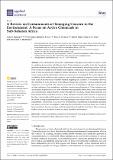| dc.description.abstract | : Active chemicals are among the contaminants of emerging concern that are rarely covered
in regulatory documents in sub-Saharan Africa. These substances are neither in the list of routinely
monitored substances nor in the guidelines for routine environmental monitoring activities. This has
been of concern to public health officials, toxicologists, communities, and governments, hence the
need for risk assessment and regulation of these substances. In this review article, the presence of
active chemicals in the sub-Saharan African environment was investigated. The results indicate the
availability of few studies in some countries, while in other countries no reports of active chemicals
were found, hence the need for further research targeting such countries. It was further observed
that mixtures of active chemicals from different therapeutic categories—such as antibiotics and
analgesics—were reported. The natural environment is increasingly at risk due to the presence
of these substances, their metabolites, and their transformation byproducts. These substances are
characterized by persistence as a result of their non-biodegradable nature; hence, they circulate from
one environmental compartment to another through the food chain, causing harm along the way.
Most studies that evaluated the toxicity of these substances considered the effects of a single drug,
but observations indicated the presence of drug mixtures, hence the need for further evaluation of
the effects of drug–drug interactions—including synergistic and additive effects—for environmental
sustainability. The presence of ACs in several environmental compartments at quantifiable quantities
was discovered in this investigation, indicating the potential for ecosystem injury as a result of
bioaccumulation, bioconcentration, and biomagnification through the food chain. This necessitates
further research on the subject in order to ensure a healthier environment. | en_US |

